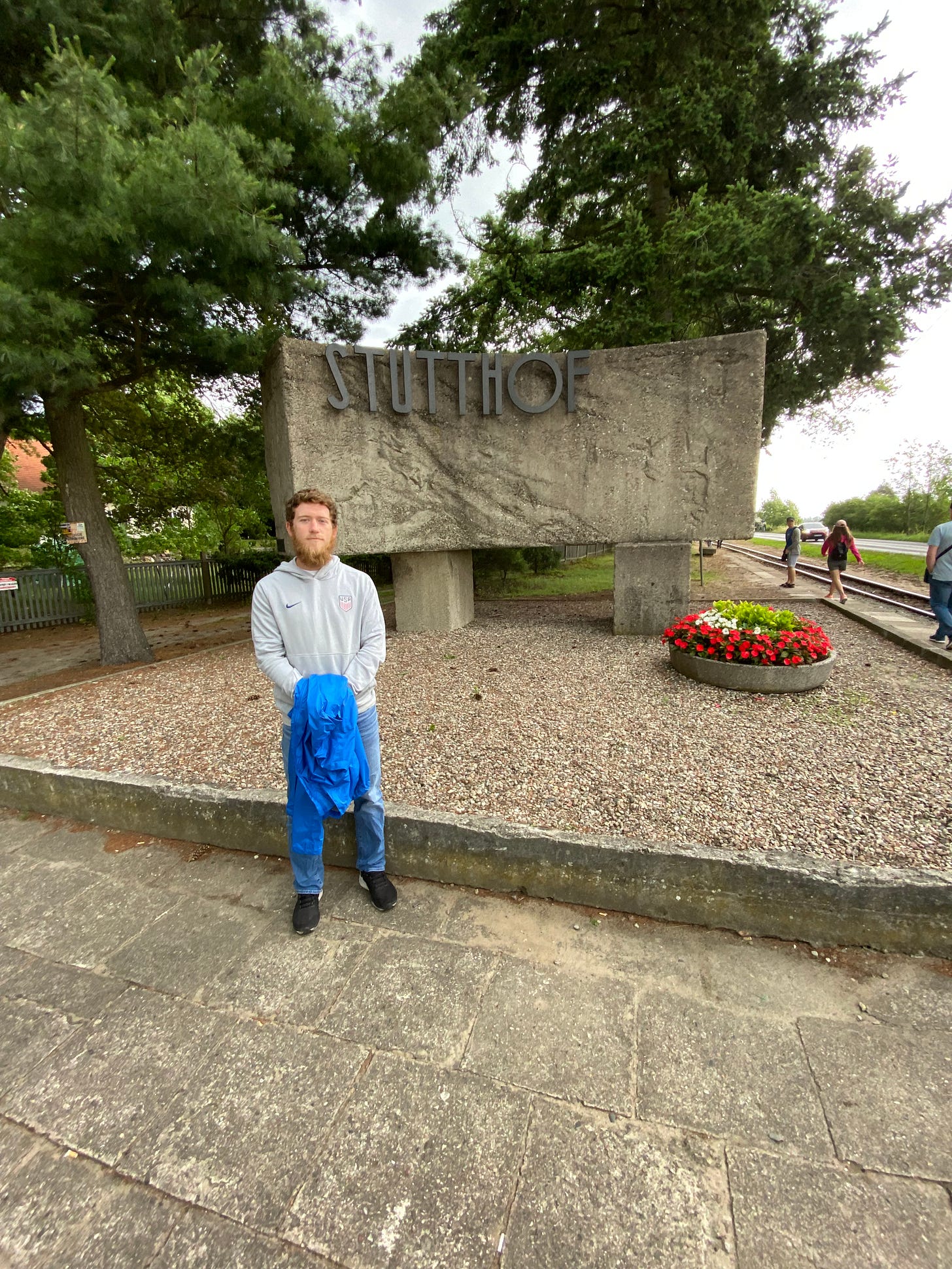Surprise, I’m back!
I know it has been ages and interest has surely waned, but I owe it to myself and others to finish what I started long ago. So, with that being said, let’s get to it.
July 4, 2023, was one of the most impactful days I have ever experienced. It all started when I walked down to the train station early in the morning. Although I despise waking up early, it was quite easy to do so on this day because I was eager to meet my good friend, Marcin, and embark on our highly anticipated trip.
During the previous weeks, I had created a bucket list of activities that I absolutely had to experience before I returned to the United States. Some of those items, such as going to the upside-down house, wax figure museum, and theme park, were already taken care of, and crossed off the list. The most important item still remained- visit a World War II concentration camp. Thankfully, Marcin was kind enough to journey with me to Sztutowo.
My short train ride went by quickly and I met Marcin, who was waiting on the opposite side of the tracks. We then began our roughly 85-minute drive, discussing Polish history along the way.
For Marcin, this was not his first visit to Stutthof. Throughout the years, he had visited several times, and, for him, it was quite personal. Decades ago, his great-grandfather was once a prisoner there because he refused to give up his land to the Germans. Luckily, he was part of the minority to make it out alive.
As we pulled up to the camp, my stomach and heart sank instantaneously. It was such a surreal sensation, one that is very hard to articulate. I could perceive the historical significance of what we were about to encounter, and it weighed heavily upon me. It was as if we were about to enter the midst of death and monstrosities beyond human comprehension, a feeling that struck deep into my core. It was a moment that I will truly never forget.
We found a parking spot and then walked back to the main entrance of the historical landmark, where we saw, again, the massive rock slab labeled “Stutthof” to denote the camp’s name. I took a picture by the rock, already feeling somber before we officially began the tour.
We retraced our steps back toward the main part of camp and embarked on a remarkable journey.
Upon entering the main gate, one of the first things I saw was a doghouse, a literal brick building formerly used to house dogs. It was a bit strange seeing one for the first time, but when I thought deeper about the purpose of such a building, it was a sad sight to behold.
We continued down a stone pathway. On our right, there was a nice fountain surrounded by well-kept shrubs. It was a beautiful, picturesque scene, which posed a strange juxtaposition with the rest of the camp.
Slightly up ahead, we saw a massive brick building which once functioned as the SS guardhouse and headquarters, so we stopped to take a brief moment and look inside.
What really stood out to me was a prison cell that appeared to be solitary confinement. The door was open, so I peered inside the cell.
On the left-hand side were two long pieces of wood that combined to form a makeshift bed. It appeared very narrow, rough, and, one could imagine, highly uncomfortable. Furthermore, even though there were lights on in the hallway, most of the cell remained very dark. It was hard to fathom the extreme darkness that a prisoner withstood if the door was closed and zero light entered the room.
To continue with the misery that was apparent within the cell, there was a mugshot of a prisoner on the wall. The poor man had an incredibly sad, harrowing frown upon his face. It was a gut-wrenching image and one of the countless reminders of the horrors these people endured as their reality.
We continued to the main portion of the camp.
First up was the “Death Gate,” as it was referred to by the prisoners. Before I proceed, it is worth mentioning that, as with every other structure of high importance at the camp, there were educational signs nearby. Luckily, most of them included English, so we often paused to read.
The sign at the “Death Gate” stated, “1940-1941, the wooden construction of the main gate leading to the Old Camp was built. The inmates used to call it the ‘Death Gate.’ Standing in front of it, the column of newcomers waited to be admitted into the camp. After the registration, which took place in the administration barrack, the next stage of the ‘welcome ceremony’ took place after passing through the ‘Death Gate.’ There, one of the SS officers would hold a speech, giving the inmates a picture of the place that they got to and what was expecting them; and afterwards, the inmates’ personal belongings were taken away from them and a humiliating examination took place. Also, a bath combined with disinfection was obligatory. About 110,000 people went through the camp’s gate. About 65,000 inmates- the victims of the camp- never got to be free again.” This was a staggering, detailed account with statistics that were nearly incomprehensible.
The image of the “Death Gate” itself was rather intimidating. The gate was tall with patterned, see-through doors that parted in the middle, presumably for vehicles or large groups of people to enter. On the left side of the gate were stairs that led to a watchtower, which rested directly above the gate. On the right side, there was a small door that we used to enter the prisoner’s portion of the camp.
All around us, the entire area was surrounded by a rusty barbed wire fence, making it a surreal experience to look up at the watch tower and envision the perspective of those trapped within.
We made our way into the camp and came across the barracks, two incredibly long buildings primarily used to house prisoners. As soon as we stepped foot inside the first barrack, I was struck by a sobering image, a mountainous pile of shoes, easily several feet tall. The shoes were encased within a glass container that filled up the majority of the room.
Now, I was aware of memorials such as this existing but seeing it with my own two eyes was entirely different. Being able to witness, in real time, the magnitude of death and destruction, the true meaning behind those shoes, was absolutely staggering. Sadly, as the picture on the wall depicted, this only seemed to be a fraction of what once was there.
We worked our way through several more barracks, which were quite interesting. While they were, for the most part, naturally preserved, the buildings had been converted into museums with many pictures and educational signs to read. Although the sheer amount of information was difficult to digest, I tried to consume as much as possible.
When Marcin and I finished touring the first portion of the barracks, we made our way toward the tail end of the camp. Along the way, we followed another barbed wire fence, which I understand may sound like a minute detail, but the imagery was astounding. I snapped a couple of photos as we strolled and tried to visualize, once again, what I was seeing from the lens of the prisoners.
Once we made it through the next gate, I was surprised to see the buildings on this side of the fence were nearly all torn down, with the brick outlines being all that remained. I asked my friend what once stood there, and he told me they used to be workshops. The forced labor was a major function of the camp.
I gazed into the distance to view what lay up ahead. There were two buildings, one small and the other larger, with an incredibly tall chimney. My heart sank at the realization of what they were, a gas chamber and crematorium.
Arriving at the gas chamber was yet another gut-wrenching experience. To my utter disbelief, the smell of chemicals was still very noticeable despite the decades of unuse. Perhaps it was naive to think that would not be the case, nevertheless, it was still mind-blowing to observe.
The chamber itself was a relatively small brick building. At each end were steel doors that served as the only source of entrance and exit. Inside of the steel doors were wooden door frames that had barbed wire spread across them. We peeked through the barbed wire to get a closer look of the chamber’s interior.
The room consisted of a brick floor and noticeably stained concrete walls. There also appeared to be a long, concrete bench that was a couple of feet wide and stretched the length of the room, on the left-hand side. Placed in the middle of the bench were a lantern and wreath of flowers to serve in remembrance of those who perished within those four walls.
As you can imagine, this was one of the most surreal experiences of not only the day but my entire life. Standing at the entrance of a literal chamber of death was incredibly heavy. It offered an infinitesimal, yet extremely powerful glimpse of what these poor souls had to endure, such immense anguish and torture. It was quite eye-opening and difficult to imagine a bleaker scenario one might face than this.
Just a few yards away was the crematorium. It was a long building with a tall, brick chimney rising from the top. To state the obvious, this was where they would bring the bodies to dispose of them.
We entered the building and saw two large brick furnaces. They each had wide metal doors with an apparatus attached to them that would slide the bodies inside. Each furnace also had memorial flowers, and a candlelight placed in front of them. In the middle, there were roses wrapped with a ribbon. Both the roses and the ribbon were red and white, the national colors of Poland, and a Catholic rosary was placed above them.
There were a few images in the educational portion of the room that depicted the level of monstrosities that took place, but I will spare everyone the gruesome details.
Just beyond the crematorium was a small portion of open land with several trees spread out. Once again, it was peculiar to have such beautiful natural scenery in a place where crimes against humanity occurred.
We took a quick view of the nearby gallows and walked back toward the main part of camp to tour the barracks opposite of what we already viewed.
The most interesting part of the first barrack was its medical area, which consisted of an examination and operating room.
The examination room had dark wooden floors with white wooden walls and ceiling. In the middle of the room, there were two wooden tables stacked on top of each other. The bottom one had tiny, miniature legs but was long in length. The table stacked on top was shorter in length, but its legs were elongated. I cannot say for sure what its purpose was, but I would infer it was used as furniture to place medical equipment.
The left side of the room was where the patient would have been positioned. There was a metal table, not very large, with wheels on each leg. The dainty appearance of the table, in conjunction with the wheels, did not make it seem like a reliable, sturdy structure. The rest of the room consisted of a wooden stool, sink, pot to boil water, lamp post, trash can, and back door that led outside.
With the knowledge we now have of how rampant disease could be within concentration camps, I would wager this room was used quite frequently. Awful diseases such as typhus, tuberculosis, dysentery, etc., were rather common. While I could imagine the Germans wanted to at least keep their prisoners free from illness so they could work in the shops, it is hard to envision they received high-quality care.
The operating room was similar in appearance but had a few key differences in terms of what was inside it. To begin with, the operating table was placed directly in the middle of the room. However, unlike the examination table, this one appeared much sturdier with its wider wooden frame and hard plastic top. On the left side of the room, there was a neat wooden table with a glass bowl and pitcher lying on top of it. In the back, there was a portable stand with utensils resting on it and also a tall, empty, wooden cabinet. Lastly, there appeared to be a heater of some sort on the room’s right-hand side.
Again, with an understanding of the Nazi’s propensity to engage in medical experimentation, it was slightly disturbing to see a room in which those activities, at least to some extent, likely occurred.
Continuing with our tour, we caught a glimpse of the lifestyle within the barracks. In one room, we saw a few bunk beds that were roped off from the public. I am not quite sure what I expected their sleeping arrangements to be like, but bunk beds were not exactly my first guess.
A bit further was the canteen, which had a glass wall that sealed it off from the rest of the room. Regardless, we could still see the decent sized tables, arranged in a three-quarter square, that had cups and bowls on display. Though one can assume the portions, frequency, and quality of meals were likely abysmal, this image of a dining area bore a semblance of normality in a completely unnatural environment.
The final portion of the barracks contained a significant amount of artwork, some of which was unbelievably dark, while others were surprisingly uplifting.
As for the darkness, we were immediately introduced to more mugshots. It was equally interesting and unsettling to be able to put a face with the prisoners that endured the horrors of the camp, just normal, everyday people like you and me.
In continuation with the darker themed artwork, there were numerous small, white cards on display that the prisoners drew themselves. Their topics ranged from military vehicles, watch towers, daily work, bodies piled around the crematorium furnace, devastatingly sad portraits, and one that portrayed a bloodied chest with a hole in its middle and barbed wire running through it, creating an “x.” Many of the images were crushing to view, but they were very powerful first-hand accounts, and skillfully crafted, I must add.
On the bright side, there were images of the canteen, water fountain, flowers, homelands, and greeting cards, many of which were Christmas themed. One greeting card, for example, had Santa Claus carrying a Christmas tree and words that translated into “healthy holidays” at the top. Others included variations of “Merry Christmas” and winterized images of the camp.
There were two cards, in particular, that caught my attention. The first was of Christ, in a manger, surrounded by Mary and Joseph. At the bottom of the card, it had the words “Gloria in Excelsis Deo” written on it. Now, admittedly, I did not understand the meaning of this phrase until recently. After a little bit of research, I learned this is Latin for “glory to God in the highest,” and, surprisingly, it is also the title of a widely popular hymn, especially around Christmas time.
The other card that I must mention featured a large red heart with a white eagle in the middle of it, beautifully representing the Polish coat of arms. Despite being surrounded and trapped by barbed wire fencing, the eagle triumphantly broke through its restrictive barriers. I thought this was an incredibly strong image that perfectly symbolized the resilience and fortitude of the Polish people during one of the most trying times in their history.
As we made it to the final room, we saw displays of prisoner uniforms. These uniforms were white with blue vertical stripes. They had pants, a long coat, hat, and an inmate number patched over the heart. We saw one that bore the tag “P 18260.”
A few weeks ago, I used a website from the “United States Holocaust Memorial Museum” to search for this specific prisoner. Astonishingly, I found answers.
This garment belonged to a man named Stanislaw Wisniewski. He was born in Grabowo, Poland on November 1, 1913. He was listed as Catholic and belonged to the “Pole” prisoner group, hence the “P” on the uniform. It was truly remarkable, yet sad, to piece together a brief description of the man who once possessed the outfit.
The final part of the barracks had a few informational maps on display. The first was about records, which indicated that over 110,000 individuals were once registered as prisoners, an astounding number. The other maps showed the European continent and drew lines from all the other countries toward Stutthof. It was fascinating that almost every single European country had a connection that led right to this very place.
We left the final barrack and found ourselves at the front of the camp, once again. I looked up at the “Death Gate,” and examined the watchtower one last time. It was still a bizarre sight, but I tried to soak up and embrace every fleeting moment I had at this historical place.
Soon after, we left, and our journey was completed.
Going to a concentration camp was a highly impactful, life-changing opportunity. I have immense gratitude for what I was able to learn, experience, and for Marcin who facilitated our trip. To take a stroll through and be in the midst of such an important part of history was truly remarkable. It will forever be a day that is near and dear to me, a time I will never forget.
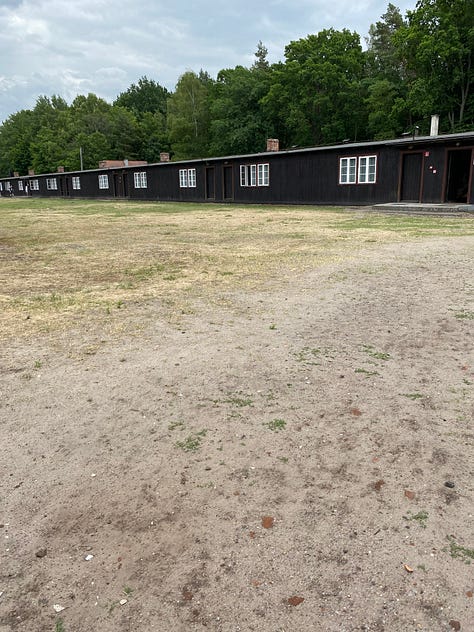
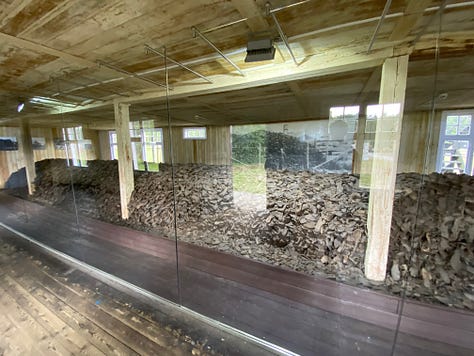
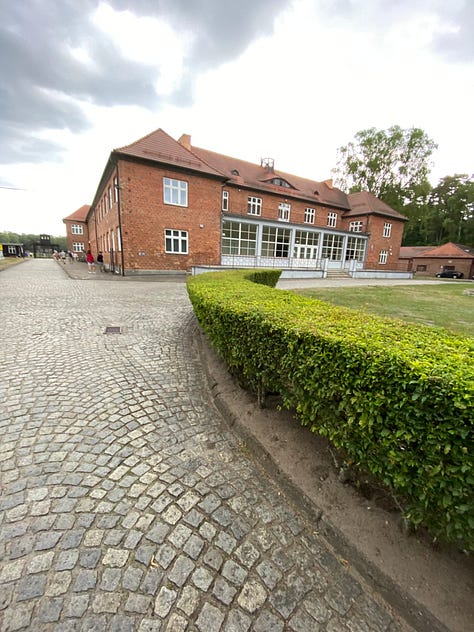
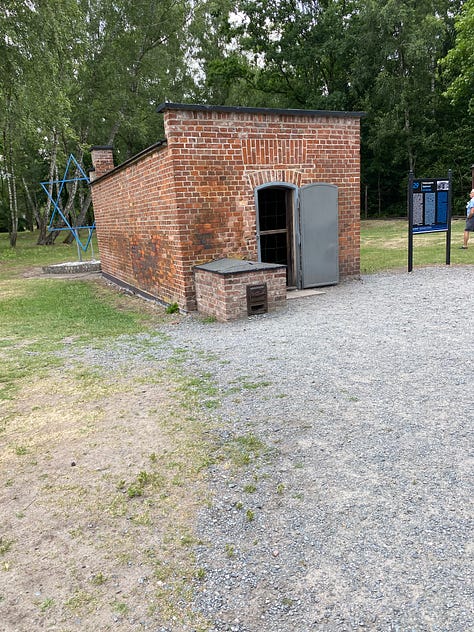
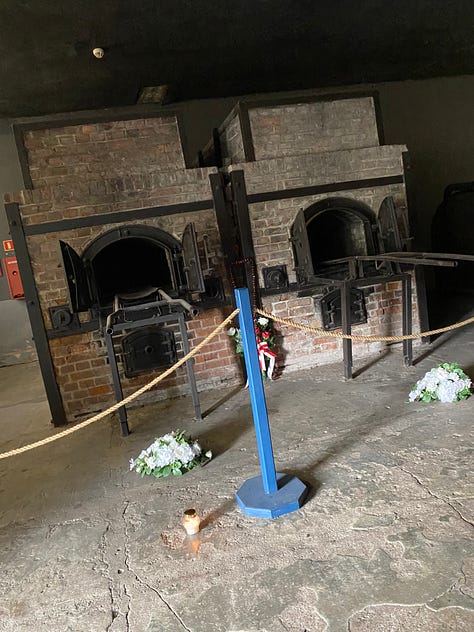
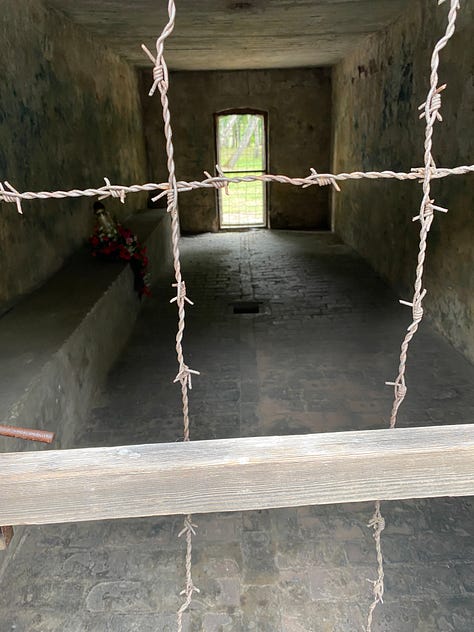
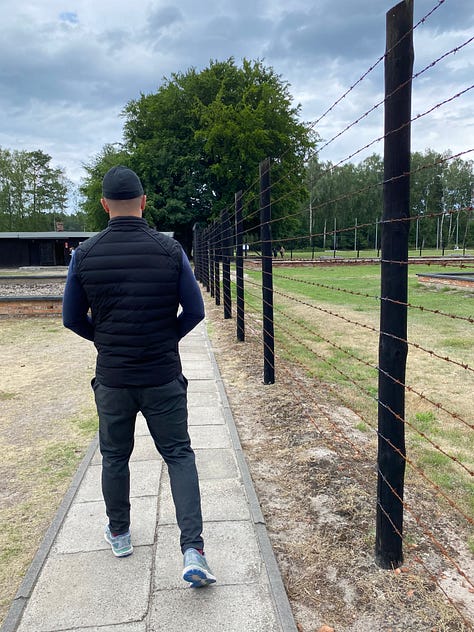
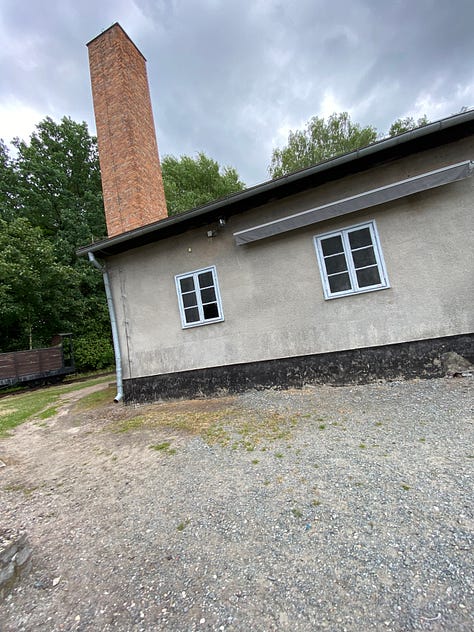
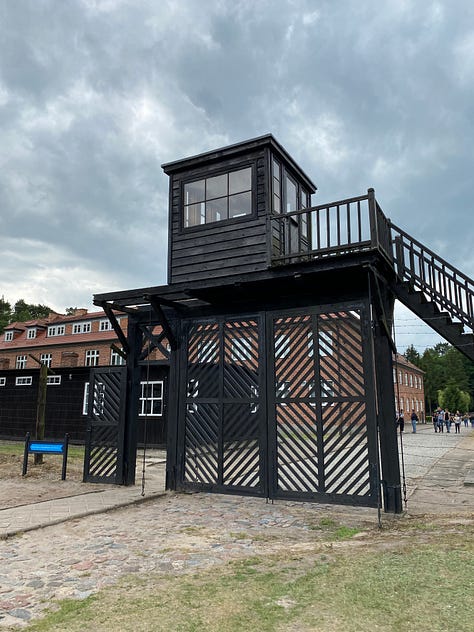
To view more images, click here.

